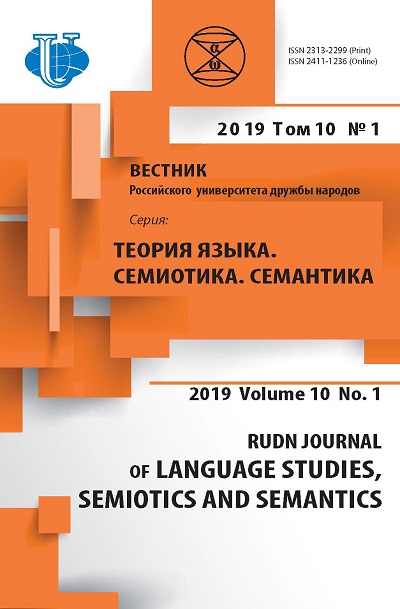THE SYNTAX OF NOVEL FIGURATIVE NAMES IN RUSSIAN AND ENGLISH: TYPOLOGICAL ASPECT
- Authors: Kiose M.I1
-
Affiliations:
- Moscow state Linguistic University
- Issue: Vol 10, No 1 (2019)
- Pages: 25-42
- Section: SYSTEMICITY IN LANGUAGE STUDIES: INTERIOR AND EXTERIOR DOMINANTS OF LINGUISTIC CATEGORIES AND UNITS
- URL: https://journals.rudn.ru/semiotics-semantics/article/view/20888
- DOI: https://doi.org/10.22363/2313-2299-2019-10-1-25-42
- ID: 20888
Cite item
Full Text
Abstract
The study reveals the syntactic features of novel figurative names and nominal constructions in texts in application to typologically different Russian and English languages. The data obtained helped to clarify the role of predication in salience enhancement, which encompasses novel figurative names construal. We conducted the two-staged contrastive analysis, which allowed to detect several specific parameters and synchronization means demonstrating the typological diversity of the two languages. As it is the salience that serves as one of the basic factors of successful reference identification in terms of implicitness and figurativeness, the research results will play a role in explaining why indirect names are interpreted differently. At the first stage we applied the statistical analysis to detect typologically relevant characteristics of syntactic positioning in terms of novel figurative names and nominal constructions. At the second stage we developed the procedure of 54 and 56 parameter correlation analysis to synchronize the lexical, syntactic and narrative parameters with figurative names in subject and predicate positions. These correlations revealed a group of parameters activated in the English language and restricted in Russian. The subject salience parameters involve the use of substantiated attribute in pre-position, sentence final position with predicate in pre-position. The predicate salience parameters were hybrid morphological character of predicate indirect names, explicit exteroception in pre-position or in the name itself, characterizing focus of indirect names (metaphoric transfer). At the same type due to syntactically salient predicate position such indirect names could allow non-agentive event role and orthographic non-markedness.
About the authors
Maria I Kiose
Moscow state Linguistic University
Author for correspondence.
Email: maria_kiose@mail.ru
Doctor of Philology, assistant professor, Moscow State Linguistic University, leading researcher at the Centre for socio-cognitive discourse research
38, Ostozhenka str., Moscow, Russia, 119034References
- Rosch, E. (1978). Principles of categorization. Cognition and categorization. Hillsdale, NY: Lawrence Erlbaum Publishers. pp. 27—48.
- Talmy, L. (2000). Toward a cognitive semantics. Concept structuring systems, 1. Cambridge, Massachusetts: The MIT Press.
- Iriskhanova, O.K. (2014). Focus games in language. Semantics, syntax and pragmatics of defocucing. Moscow: Languages of Slavonic culture. (In Russ.).
- Kubryakova, E.S. (2008; 1978). Parts of speech in onomasiological exposure. Moscow: URSS. (In Russ.).
- Iriskhanova O.K. (2004). On the linguocreative human activity: deverbative nouns. Moscow: VTII Publishing House. (In Russ.).
- Arutunova, N.D. (2007). Morphological issues of word-derivation (in Spanish). Moscow: Languages of Slavonic culture. (In Russ.).
- Foley, W.A. & Van Valin R.D., Jr. (1984). Functional syntax and universal grammar. Cambridge, England: Cambridge University Press.
- Gundel, J.K., Hedberg, N. & Zacharski, R. (1993). Cognitive Status and the form of referring expressions in discourse, Language, 69. pp. 274—307.
- Adameč, P. (1966). Word order in modern Russian. Praha: Academia. (In Russ.).
- Shmelev, A.D. (2002). Selected works on the Russian language. Moscow: Languages of Slavonic culture. (In Russ.).
- Khrakovskij, V.S. (2010). Upgrade actants’ derivation. In Language and culture space: Sound, sign, sense: collected articles in honor of V.A. Vinogradov’s 70th anniversary. Moscow: Languages of Slavonic culture. pp. 44—53. (In Russ.).
- Burov, A.A. (2012). Substantive syntactical nomination in Russian. Stavropol’, Pyatigorsk: Stavropol’ State University Publishing House. (In Russ.).
- Kubryakova, E.S. (1981). Types of linguistic meanings. Sematics of a derived word. Moscow: Nauka. (In Russ.).
- Mel’nikov, G.P. (2003). Systemic linguistics and semiotic basis to solve semantic isssues // Vestnik PUDN. Series Linguistics, 4, 5—14. (In Russ.).
- Sigal, K.Ya. (2012). Syntactic theory issues. Moscow: Kluch-S Publishing House. (In Russ.).
- Kovtunova, I.I. (1979). Structure of a literary text and new information In Textual syntax. Moscow. pp. 262—275. (In Russ.).
- Iriskhanova, O.K. (2018). On the topic of the dynamics to measure narrative In Language images and discourse curve. Collected scientific-research articles in honour of V.Z. Demyankov’s 70th anniversary. Moscow: Cultural revolution. pp. 192—215. (In Russ.).
- Paducheva, E.V. (1974). On semantics of syntax. Moscow: Nauka. (In Russ.).
- Paducheva, E.V. (1980). On the denotative status of nominal groups of sentences, Scholarly notes of the Tartu University, 519, 48—81. (In Russ.).
- Arutunova, N.D. (2005; 1976). Sentence and its meaning: logic and sematic issues. Moscow: Editorial URSS. (In Russ.).
- Arutunova, N.D. (1978). Syntactical functions of a metaphor. Izvestiya AN SSSR. Series literature and language, 37, 251—262. (In Russ.).
- Arutunova, N.D. (1990). Metaphor and discourse [Introduction]. In Theory of metaphor. Moscow: Progress. pp. 5—32. (In Russ.).
- Donnelan, K.S. (1982). Reference and definite descriptions. In Novoye v zarubezhnoj lingvistike. Moscow: Progress. Vol. 13. pp. 134—160. (In Russ.).
- Shmelev, A.D. (1983). On the reference of agent nouns. Filologicheskiye nauki, 4, 39—46. (In Russ.).
- Krylov, S.A. (1984). Determination of nouns in Russian: theoretical issues, Semiotics and Informatics, 23, 124—154. (In Russ.).
- Shatunovskij, I.B. (1996). Semantics of a sentence and non-referential words (Meaning. Communicative perspective. Pragmatics). Moscow: Studies of “Languages of the Russian culture”. (In Russ.).
- Kibrik, A.A. (1999). Cognitive inferences from discourse observations: reference and working memory. Discourse studies in cognitive linguistics. Proceedings of the 5th International cognitive linguistics conference, / K. van Hoek, A.A. Kibrik, L. Noordman (Eds.). pp. 29—52.
- Kiose, M.I. (2018). Factors of effective interpretation of indirect co-referential nominations: cognitive analysis — statistics — experiment, Issues of cognitive linguistics, 3, 16—26. (In Russ.).
- Kiose, M.I. (2018). ”Effective interpretation” of textual imagery. In Language images and discourse curve. Collected scientific-research articles in honour of V.Z. Demyankov’s 70th anniversary. Moscow: Cultural revolution. pp. 290—315.
Supplementary files












